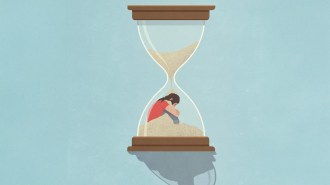Wave of resilience
India’s coastal villagers show emotional strength in tsunami's wake
When a tsunami over the Indian Ocean region flattened villages along India’s southeastern coast on December 26, 2004, the mammoth wall of water left behind not just unthinkable tragedy, but also a remarkable legacy of human resilience. Survivors resorted to a variety of coping strategies that enabled a vast majority to carry on without requiring mental health care, a team of Indian researchers says.
The tsunami killed more than 280,000 people, mainly in Indonesia, Thailand and Sri Lanka, according to the World Health Organization. India lost at least 12,400 people. More than 1 million Asians found themselves homeless, and the tsunami created other problems for another 5 million people.
Amid unprecedented devastation, residents of four hard-hit fishing villages in India’s southeastern state of Tamil Nadu employed diverse tactics to deal with myriad losses and to cultivate hope and meaning, say psychiatrist Prathap Tharyan of Christian Medical College in Vellore, India, and his colleagues. A survey of 643 villagers conducted by his group nine months after the tsunami identified symptoms of post-traumatic stress disorder in only about 6 percent of the villagers, mainly children and those who had lost loved ones in the disaster.
“These intrepid communities assiduously constructed many individual, social and spiritual barricades against chaos and despair,” Tharyan says.
“The new findings confirm that only a small percentage of people are severely affected by the tsunami,” at least from a mental health perspective, remarks WHO psychiatrist Mark van Ommeren. Still, that modest proportion translates into 250,000 to 500,000 people across South Asia in need of long-term mental health care, he notes.
Tharyan’s conclusion stems from group meetings conducted with villagers in September 2005. Two team members who spoke the local language led one-hour discussions with six groups of 10 to 15 fishermen, housewives, community leaders and young people.
The researchers’ analysis of those sessions appears online and in an upcoming Social Science & Medicine. Survey results will be submitted for publication later this year.
Most villagers lived in temporary shelters, as their village had not yet been rebuilt. Fishermen were beginning to resume daily work.
Nearly all participants had been caught in tsunami waves and had lost property and loved ones. They reported being easily startled by rampant rumors about new tsunamis and by routine noises that called to mind the roar of tsunami waves. Mothers said that their children displayed some of the worst such anxiety. Parents whose children died and women whose husbands perished in the disaster were still suffering inconsolable grief. The villagers regard widowhood as a serious loss of status and security for women. Stress disorder symptoms often appeared in people who displayed intense, ongoing grief.
Yet these people still lived near the sea and many had returned to daily routines. Their Hindu faith, spiritual conviction of oneness with the universe and regard for “mother sea” remained strong, Tharyan says.
Most participants cited religious beliefs as central to their well-being. Local ceremonies for the deceased and for distressed survivors, as well as visits from esteemed spiritual leaders, greatly aided the villagers. So did a belief that the dead would be reincarnated into higher forms of life.
In addition, community leaders frequently visited the bereaved. Social gatherings commemorated the dead. Youth attended self-help groups that boosted their confidence about rebuilding villages. Many individuals felt that God had chosen them to survive and that they had suffered less than many others had.
Tharyan’s results align with an estimate, released one month after the tsunami by WHO in Geneva, that 5 to 10 percent of tsunami survivors would develop post-traumatic stress disorder and other mental disorders. At the time, WHO officials emphasized that faith and other cultural factors play an enormous role in how people react and cope with disastrous events.
The Indian villagers used coping strategies that are strikingly similar to those of 9/11 survivors in New York City, comments psychologist George Bonanno of ColumbiaUniversity. Indians and New Yorkers gained comfort from the bonding of neighboring communities, felt tremendous pride in their post-disaster efforts and emphasized that they could have suffered much worse fates.
Nine months after 9/11, New York City’s post-traumatic stress disorder rate was slightly lower than what Tharyan reports for Indian villagers nine months after the tsunami, Bonanno says.







